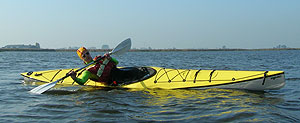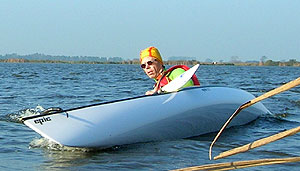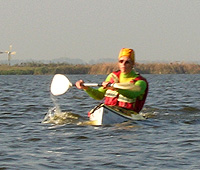Although I didn't have the whole weekend to my disposal for paddling, I could spend the afternoon for wet-exercises with the 16X. Not a bad day as the weather was very friendly; almost spring ![]()
For testing I took a very familiar paddle (an old Schlegel Racing) with the purpose to be able to concentrate only on the kayak.
Rolling
Rolling is very easy, both rolling completely backwards as well as bending forward while rolling up. Rolling backwards I was not hindered by the backrest; which I adjusted as low as possible, like I wrote before on the site.
Sculling
Is also easy to perform. The grip for the knees on the deck is perfect and I am not afraid, in spite of the big cockpit, that the knees can easily glide out of position.
High brace

Never did an easier brace; it' s just as if the 16X rolls up herself.
Re-entry&roll

Getting into the cockpit is very easy; room enough![]()
Rolling up gave me a question mark because it feels if I did not have the paddle in a good starting-position to start rolling. I thought the operating blade was still under water. Why? I don't know, so I did several re-entries and there was some improvement although I concluded that rolling the 16X with a waterlogged cockpit was heavier and not as easy written above at rolling.
Musing about the cause I found 2 possible explanations.
-It could be that I does not bend enough forward while under water. Maybe that's not a good explanation because I did not have similar experiences with rolling.
-Or the big cockpit-opening "spoons" a lot of water in the cockpit while rolling up without spraydeck
Low brace

Performing a low brace while moving forward feels very solid while the edged kayak turns nicely on the shortened waterline. While edging it can be seen that the bow and stern are lifted out of the water.
Other techniques like bow-rudder, stern-rudder, sideways sculling are all very normal to perform
Further I mused a bit about the rudder this afternoon.
While looking more closely to the rudder, I realized that the biggest part of the rudder is above the water surface. Could it be, I thought, hat this is the reason for the response of the kayak to the rudder is so slow. In waves the rudder will be lifted on the air quit often. To be honest, the rudder will be submerged quite as often of course when a waves passes by. Until now I thought that the fin at the underside of the rudder was meant to compensate for weathercocking in a way as the old fashioned integral skeg worked at older kayak designs. But now I think that it could well be that the fin contributes to the effect of steering as well. This means that, with the new steering system, it might not be a good idee to paddle with the fin hauled up.

Anyway, I paddled a bit on the lake in several directions relative to the light wind (being 4bft) and I concluded, just as before, that the 16X paddles very neutral in all directions. Using the rudder I am still not very happy because after use it takes some time before I find a stable course again. I like it most to steer the kayak by edging without using the rudder because this is the most direct method with immediate response. If I can paddle like that in a following sea is something I will find out later.
